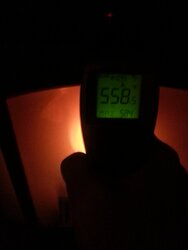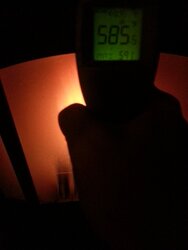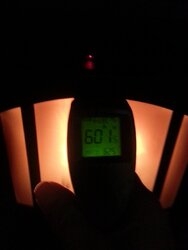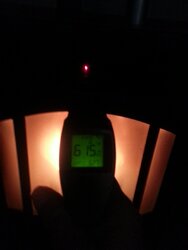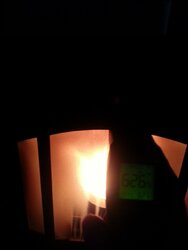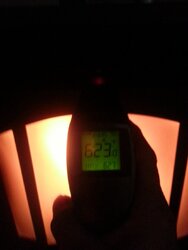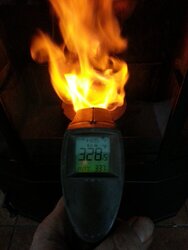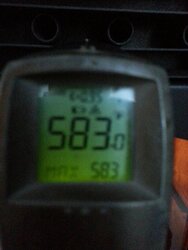Ok I got my infrared non-contact temperature gun today to measure the temp of the air coming out of the stove. How many use one? How accurate do you think they are? How much does the info effect your pellet purchasing decisions?
IR Gun
- Thread starter Caribfan
- Start date
-
Active since 1995, Hearth.com is THE place on the internet for free information and advice about wood stoves, pellet stoves and other energy saving equipment.
We strive to provide opinions, articles, discussions and history related to Hearth Products and in a more general sense, energy issues.
We promote the EFFICIENT, RESPONSIBLE, CLEAN and SAFE use of all fuels, whether renewable or fossil.
You are using an out of date browser. It may not display this or other websites correctly.
You should upgrade or use an alternative browser.
You should upgrade or use an alternative browser.
- Status
- Not open for further replies.
St_Earl
Minister of Fire
AK13
Feeling the Heat
I think that IR guns are typically very accurate as long as you don't point them at shiny metal. They will give you the surface temp of what you point them at, not really the air temp.
Yes, good point. But I would think the hotter the air, the hotter the metal so it should give a good indication....right?
St_Earl
Minister of Fire
better to use a stove gauge hung in the air path not touching the metal.
i would think even a decent oven thermometer placed in the same manner would give more useful results than any measure of surface temp.
your metal surface temp will be much higher than your air temp.
i would think even a decent oven thermometer placed in the same manner would give more useful results than any measure of surface temp.
your metal surface temp will be much higher than your air temp.
Last edited:
peirhead
Feeling the Heat
I think the metal at the exit of your convection air will give you a very good reference point,,,,maybe even better than the air itself. After all it is the air passing over the heat exchangers that heats up the metal where it exits...not the stove heat itself (IMHO)
Pete Zahria
Minister of Fire
Using an IR gun no matter where you use it, is used for comparisons.
But it won't measure air.
It really doesn't matter where, or what you measure. As long as you measure
the same spot every time.
I use a section of the stove side, the size of a quarter.
I read the temp. If I make a change to the heat/blower setting, after a couple of hours,
I measure it again. I also sprayed a circle on the vent pipe,
the size of a donut, flat black. I measure that as well.
That gives me a kind of crude relationship, between stove/vent.
If you feel the vent should be cooler, then you can make a change on your stove settings.
Check temps again, to see if there was any change.
You can also check pellet quality.
Use a different pellet, and with the same settings as your baseline pellet,
see if they were hotter or colder.
At least that is what I use mine for...
Dan
But it won't measure air.
It really doesn't matter where, or what you measure. As long as you measure
the same spot every time.
I use a section of the stove side, the size of a quarter.
I read the temp. If I make a change to the heat/blower setting, after a couple of hours,
I measure it again. I also sprayed a circle on the vent pipe,
the size of a donut, flat black. I measure that as well.
That gives me a kind of crude relationship, between stove/vent.
If you feel the vent should be cooler, then you can make a change on your stove settings.
Check temps again, to see if there was any change.
You can also check pellet quality.
Use a different pellet, and with the same settings as your baseline pellet,
see if they were hotter or colder.
At least that is what I use mine for...

Dan
MarkSJohnson
Member
I measure the same spot on a blower vent fin. I don't know how accurate it is to the REAL temp, but it's repeatable so I assume that it's useful for comparisons.
I used it initially to see relative heat from different pellets and now to to adjust the air intake for maximum temp output.
I used it initially to see relative heat from different pellets and now to to adjust the air intake for maximum temp output.
I measure the same spot on a blower vent fin. I don't know how accurate it is to the REAL temp, but it's repeatable so I assume that it's useful for comparisons.
I used it initially to see relative heat from different pellets and now to to adjust the air intake for maximum temp output.
Correct, you can use it for comparisons when you change one thing at a time. Keep in mind, though, that when you measure the heat exchanger directly (the blower vent fin), that metal is in direct contact with the combustion gases and its temperature will vary with the normal ups & downs of flame height. It's best to take several measurements before coming to any conclusions.
Bioburner
Moderator
I got one from newegg two years ago for $25 delivered. Pretty accurate for non reflective surfaces. Used for stove vent surface temps when shot with a spot of flat black stove paint. Tuned a cycles exhaust. Finds cold leaks around doors. Took dogs temp and was the same as probe. I hang a probe type meter to measure air temps. Got four indoor-outdoor electric gauges with meter of probe wire from Amazon for $12.
tjnamtiw
Minister of Fire
Not necessarily. It depends on if you have turbulent flow or laminar flow. If you have laminar flow, there is a stagnant layer of air along the surface of the tube that insulates the tube from the air moving past it. Also the air temperature depends on how fast the air is moving along the tube. The faster it is moving, the less time it has to remove heat so it won't be as hot. Of course, since there is a larger volume of air moving past the tube's wall, the total btu's may be about the same either way. But you wanted air temperature, which really isn't as relevant as btu's supplied by the stove. IR guns will NOT measure air.Yes, good point. But I would think the hotter the air, the hotter the metal so it should give a good indication....right?
One other point to look for on your heat gun is whether there is a switch setting for dark or shiny surfaces, as AK13 said. I used both IR guns and direct contact probes in my work for many years and IR guns, especially cheap ones are worth a crap for accuracy BUT they will PROBABLY give you an indication of variations in temperatures as many above have said. That's all you really need to see which set up gives you more heat IF ALL OTHER VARIABLES REMAIN CONSTANT. You must change only one thing at a time for an experiment to be accurate.
If you want accuracy, then look for a used surface contact pyrometer on EBay. http://www.ebay.com/itm/Therma-Tray...615?pt=LH_DefaultDomain_0&hash=item258818346f This is a good instrument but doesn't have the right probe for surface temperature BUT that tip would slide right into your tubes and avoid touching the metal giving you an air temperature. $5 is fantastic! If you don't want it, I think I will bid on it because I don't have that probe.
http://www.ebay.com/itm/tif-7000-Th...956?pt=LH_DefaultDomain_0&hash=item2a3690a2cc This one is top of the line and very nice. ''The TIF7000, the original TIF Thermometer, comes with 3 different probes. The first is the Air Probe which can be used for instant readings of air temperatures from –40ºF to over 1000ºF. The second probe, the Surface Probe, is used for quick surface readings from –40ºF to 1999ºF. The Immersion probe tests liquid temperature from –40ºF to 500ºF.''
MarkSJohnson
Member
Oooops! Yes, I forgot to mention that I take 5-6 readings over 5-10 minutes and average them.its temperature will vary with the normal ups & downs of flame height. It's best to take several measurements before coming to any conclusions.
Mt Bob
Minister of Fire
Have been using that model for years,as a mechanic.The hot wire sensor is great for measuring air out your vehicles vents,very acurate.Not necessarily. It depends on if you have turbulent flow or laminar flow. If you have laminar flow, there is a stagnant layer of air along the surface of the tube that insulates the tube from the air moving past it. Also the air temperature depends on how fast the air is moving along the tube. The faster it is moving, the less time it has to remove heat so it won't be as hot. Of course, since there is a larger volume of air moving past the tube's wall, the total btu's may be about the same either way. But you wanted air temperature, which really isn't as relevant as btu's supplied by the stove. IR guns will NOT measure air.
One other point to look for on your heat gun is whether there is a switch setting for dark or shiny surfaces, as AK13 said. I used both IR guns and direct contact probes in my work for many years and IR guns, especially cheap ones are worth a crap for accuracy BUT they will PROBABLY give you an indication of variations in temperatures as many above have said. That's all you really need to see which set up gives you more heat IF ALL OTHER VARIABLES REMAIN CONSTANT. You must change only one thing at a time for an experiment to be accurate.
If you want accuracy, then look for a used surface contact pyrometer on EBay. http://www.ebay.com/itm/Therma-Tray...615?pt=LH_DefaultDomain_0&hash=item258818346f This is a good instrument but doesn't have the right probe for surface temperature BUT that tip would slide right into your tubes and avoid touching the metal giving you an air temperature. $5 is fantastic! If you don't want it, I think I will bid on it because I don't have that probe.
http://www.ebay.com/itm/tif-7000-Th...956?pt=LH_DefaultDomain_0&hash=item2a3690a2cc This one is top of the line and very nice.
tjnamtiw
Minister of Fire
Yep, it's a great, indestructible baby!Have been using that model for years,as a mechanic.The hot wire sensor is great for measuring air out your vehicles vents,very acurate.
boomhour
Burning Hunk
Just some temps I been hitting now and again, using the gun strictly for pellet choice and fine tuning stove. The pics. are a run up from stage 1 to 4 over 20 mins. Satisfaction sold at HD have my vote for sleeper pellet of the year.
Attachments
St_Earl
Minister of Fire
Just some temps I been hitting now and again, using the gun strictly for pellet choice and fine tuning stove. The pics. are a run up from stage 1 to 4 over 20 mins. Satisfaction sold at HD have my vote for sleeper pellet of the year.
according to those readings, you can easily ignite paper on the surface of your stove.
(even accounting for bradbury being off low by 30 degrees.
 )
)PDF]
Ignition Temperatures
ir.library.oregonstate.edu/xmlui/bitstream/.../Bulletin%20No.%2026.pdf?...
Last edited:
It may be reading temperatures through the glass...according to those readings, you can easily ignite paper on the surface of your stove.
St_Earl
Minister of Fire
ok, even though the auto ignition temp of newsprint is between 480 and 500f, actual ignition depends on specific conditions.
in the study linked, it appears the samples were rotated in an oven for even heating and specific airflows were used.
so probably you couldn't light paper on a surface with the minimum auto ignition temp.
the paper should at least blacken though
i suppose this is all beside the point.
i just prefer to know the air temp coming out of my stove.
to each their own.
in the study linked, it appears the samples were rotated in an oven for even heating and specific airflows were used.
so probably you couldn't light paper on a surface with the minimum auto ignition temp.
the paper should at least blacken though
i suppose this is all beside the point.
i just prefer to know the air temp coming out of my stove.
to each their own.
Last edited:
M
Madcodger
Guest
Use one all the time to measure temp at a specific spot, from a specific distance from the stove. Appears to be reasonably accurate, and I do rely on it to make pellet purchase decisions, along with characteristic of the burn, amount of ash, etc.
Harvey Schneider
Minister of Fire
There is nothing that beats a thermocouple for measuring air temperature. Simply suspend the thermocouple in the air stream and you have almost instant measure of the air temperature.
Even cheap thermocouple meters available on ebay are amazingly accurate and they are available at a cost far lower than IR meters. IR meters have their place, but they get used for many applications where they just aren't very good. Measuring stove air temp is one of them.
You still have to wait for the stove temperature to stabilize and you still should average several readings, but because of the speed of a thermocouple you can easily scan the air stream looking for the temperature profile.
Just my $0.02.
Even cheap thermocouple meters available on ebay are amazingly accurate and they are available at a cost far lower than IR meters. IR meters have their place, but they get used for many applications where they just aren't very good. Measuring stove air temp is one of them.
You still have to wait for the stove temperature to stabilize and you still should average several readings, but because of the speed of a thermocouple you can easily scan the air stream looking for the temperature profile.
Just my $0.02.
stratocaster1422
Member
Do none of you guys BBQ? If you do, you should have one of these already. Hang the BBQ probe in the air stream
http://www.amazon.com/Maverick-Et-732-Remote-Smoker-Thermometer/dp/B004IMA718
http://www.amazon.com/Maverick-Et-732-Remote-Smoker-Thermometer/dp/B004IMA718
Harvey Schneider
Minister of Fire
Great if you already have one, but a bit pricey compared to either IR or thermocouple meters available.Do none of you guys BBQ? If you do, you should have one of these already. Hang the BBQ probe in the air stream
http://www.amazon.com/Maverick-Et-732-Remote-Smoker-Thermometer/dp/B004IMA718
boomhour
Burning Hunk
according to those readings, you can easily ignite paper on the surface of your stove.
(even accounting for bradbury being off low by 30 degrees.)
PDF]
Ignition Temperatures
ir.library.oregonstate.edu/xmlui/bitstream/.../Bulletin%20No.%2026.pdf?...
May get a chance heading to -30 tonight and chills to -35
 .
.boomhour
Burning Hunk
It may be reading temperatures through the glass...
First pic. through the looking glass, second at the heat exchanger, same spot as always.
Attachments
- Status
- Not open for further replies.
Similar threads
- Replies
- 17
- Views
- 888
- Replies
- 16
- Views
- 1K
- Replies
- 0
- Views
- 317
- Replies
- 24
- Views
- 2K


